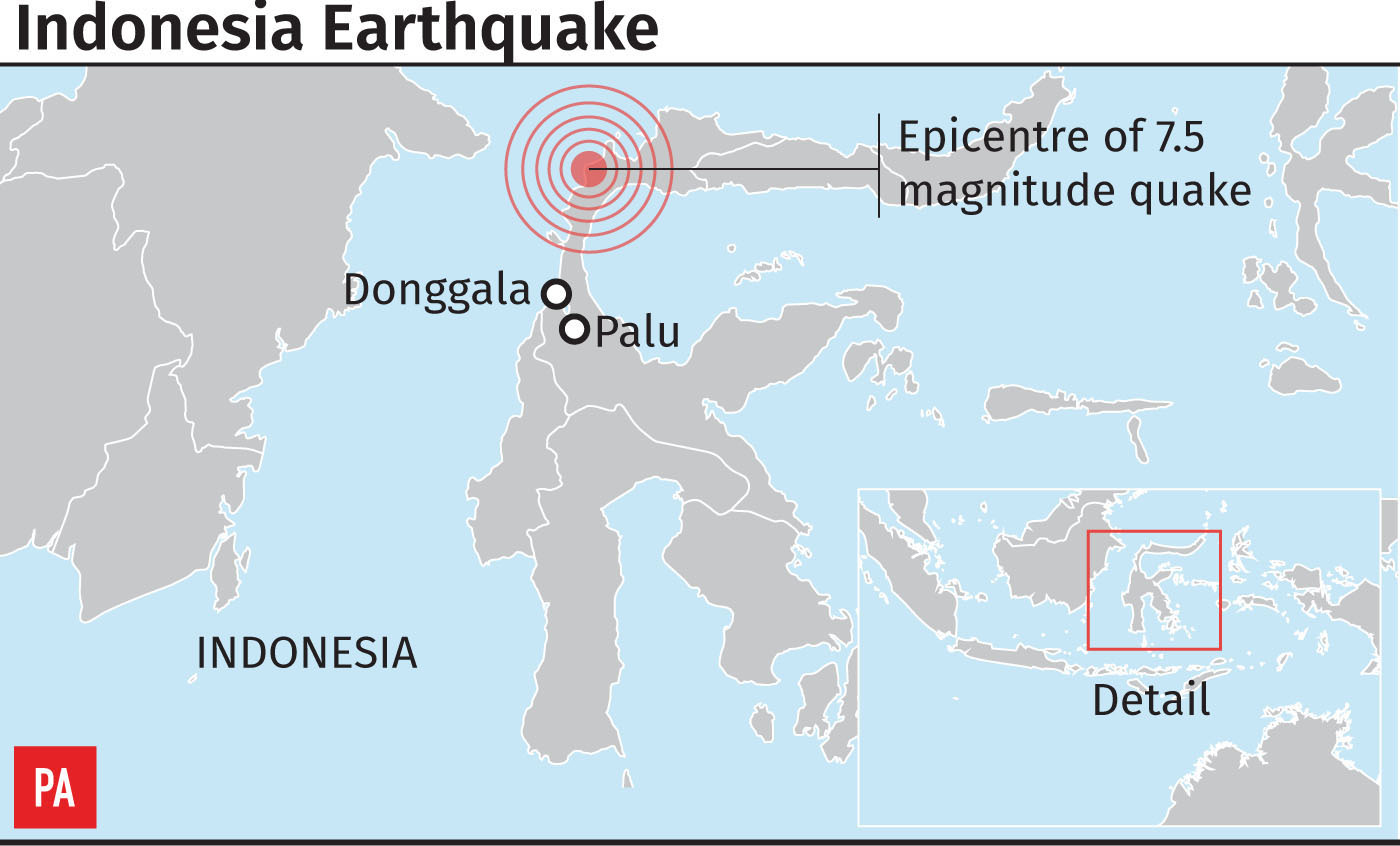
The death toll from an earthquake and tsunami that decimated parts of the central Indonesian island of Sulawesi has jumped to more than 1,200.
It comes as disaster officials began reaching coastal areas that were cut off by blocked roads and downed communications lines.
Officials said hundreds of other people were severely injured and that scores of bodies could still be buried under quicksand-like mud caused by Friday’s magnitude 7.5 earthquake.
More than 25 countries have offered assistance after Indonesian President Joko “Jokowi” Widodo appealed for international help.
Little of that, however, has arrived in the quake zone and increasingly desperate residents grabbed food and fuel from damaged shops and begged for help.
Rescuers have focused much of their attention so far on the biggest affected city, Palu, which has 380,000 people and is easier to reach than other hard-hit areas.
“We feel like we are stepchildren here because all the help is going to Palu,” said Mohamad Taufik, 38, from the town of Donggala, who said five of his relatives are still missing.

“There are many young children here who are hungry and sick, but there is no milk or medicine.”
Along the coast, the tsunami, which reportedly reached as high as six metres (nearly 20ft) in some places, shattered buildings, uprooted concrete and thrust houses and boats tens of metres inland.
The death toll for all affected areas reached 1,234, national disaster agency spokesman Sutopo Purwo Nugroho said in Jakarta, the capital.
He said more people remain trapped in Sigi and Balaroa, meaning the toll is likely to rise.
Mr Nugroho said more aid was being distributed but “we still need more time to take care of all the problems”.

He said 153 bodies were buried on Monday in a mass grave and that the operation continued on Tuesday.
A special aircraft carrying 12,000 litres of fuel had arrived and trucks with food were on the way with police escorts to guard against looters.
Mr Nugroho said many petrol stations were inoperable either because of quake damage or from people stealing fuel.
The frustration of waiting for days without help boiled over for some.
“Pay attention to Donggala, Mr Jokowi. Pay attention to Donggala,” yelled one resident in a video broadcast on local television, referring to the president.
“There are still a lot of unattended villages here.”
The town’s administrative head, Kasman Lassa, all but gave residents permission to take food – but nothing else – from shops.
“Everyone is hungry and they want to eat after several days of not eating,” Lassa said on local TV.
“We have anticipated it by providing food, rice, but it was not enough. There are many people here. So, on this issue, we cannot pressure them to hold much longer.”
Desperation was visible in Palu as well.
Signs propped along roads read We Need Food and We Need Support, while children begged for cash in the streets and long lines of cars snarled traffic as people waited for fuel.

Teams were searching for trapped survivors under destroyed homes and buildings, including a collapsed eight-storey hotel in Palu, but they needed more heavy equipment to clear the rubble.
Nearly 62,000 people have been displaced from their homes, Mr Nugroho said.
Many people were believed trapped under shattered houses in the Palu neighbourhood of Balaroa, where the earthquake caused the ground to heave up and down violently.
“I and about 50 other people in Balaroa were able to save ourselves by riding on a mound of soil which was getting higher and higher,” resident Siti Hajat told MetroTV, adding that her house was destroyed.
In Palu’s Petobo neighbourhood, the quake caused loose, wet soil to liquefy, creating a thick, heavy quicksand-type material that resulted in massive damage.
Hundreds of victims are still believed to be buried in the mud there.
Liquefaction of soil can be compared to walking on a sandy beach.
“If you walk across some wet sand a little back from the water’s edge, it is usually firm walking, even though you might leave footprints,” said Adam Switzer, an expert at the Earth Observatory of Singapore.

“However, if you stand still and wiggle your toes and feet, you will probably sink a little as the sand around your feet becomes soft and unstable. This is similar to what happens during liquefaction.”
Mr Nugroho said generators, heavy equipment and tents are among the most-needed aid items.
The countries that offered assistance include the United States and China, he said.
Australian Prime Minister Scott Morrison said his government has given 360,000 dollars to help victims and is in talks with Indonesian authorities about a second round of aid.
The initial funds are to go to the Indonesian Red Cross for the most obvious emergency aid needs, such as tarpaulins.
Mr Nugroho said only two of the 122 foreigners in the area remained unaccounted for – one from South Korea and the other from Belgium.
Indonesia is frequently struck by earthquakes, volcanic eruptions and tsunamis because of its location on the Ring of Fire, an arc of volcanoes and fault lines in the Pacific Basin.
A powerful quake on the island of Lombok killed 505 people in August, and two moderate quakes near an eastern island on Tuesday reportedly damaged a bridge.
The vast archipelago is home to 260 million people on more than 17,000 islands that stretch a distance similar to that between New York and London.
Roads and infrastructure are poor in many areas, making access difficult in the best of conditions.


Comments: Our rules
We want our comments to be a lively and valuable part of our community - a place where readers can debate and engage with the most important local issues. The ability to comment on our stories is a privilege, not a right, however, and that privilege may be withdrawn if it is abused or misused.
Please report any comments that break our rules.
Read the rules here